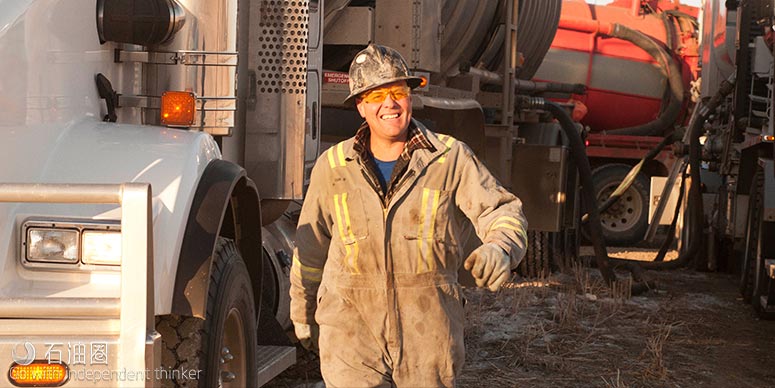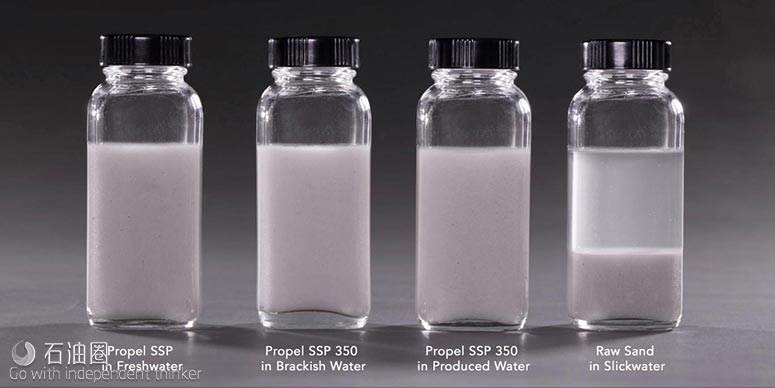
是什么,让企业在动荡时代站稳脚跟?墨守成规总归不是妙计。
来自 | E&P
编译 | 二丫 影子
所谓包装,对于石油行业来说,更多的便是给自己的技术配上个悦耳的名字。甚至很多时候,哪怕是些本质意义近乎完全相同的东西,生产商也要给它们穿上各色马甲,试图将自己与路人甲区别开来。这样做无非是想吸引注意力,让自己的产品能在市场条件下尽可能多地收获利润。但在当下的低油价环境中,这种做法无疑是掩耳盗铃。
一些选择继续挣扎在这场混战中的油企终于意识到,更经济有效的油气生产方式,才是这次革命最珍贵的本钱。在这一动力的催使下,于是便有了以下数据。
调查结果表明,二叠纪盆地的盈亏平衡油价下降到46美元/桶,Eagle Ford 48美元/桶,SCOOP/STACK则下降到47美元/桶。而根据达拉斯联邦储备银行的数据,米德兰盆地的一些运营商正在尝试将盈亏平衡油价定位在25美元/桶水平上。
毋庸置疑,精简业务在这种低盈亏平衡的趋势走向中的确起到了很重要的作用,但新技术、新工具和新系统也不外乎是另一关键因素。如果将人类的技术发展历程分为石器时代、工业革命时代和信息时代三个阶段,那么其实能源行业也同样存在着这种阶段性规律。数十年以后,当人们再次回过头来看时,将会看到一个漫长的经济衰退期,与此同时也会意识到,原来一个专属于油气行业的“创新时代”,竟真真切切地存在着。
在这场革命的浪潮中,美国螯里独尊。本次介绍的系列专题,就是围绕驱动美国油气工业迅猛发展的公司和创新生产技术来展开讨论的。
新型支撑剂技术提高压裂水源兼容性

溶于新鲜水、含盐水甚至采出水时,Propel SSP都会实现膨胀和自悬浮
水力压裂的迅速扩张造成了整个行业的水资源管理问题,无论是淡水采购还是生产水处理,无一例外。增产项目的增长,正在将油气行业置于与政府和其他行业对饮用水的竞争中。自悬浮支撑剂(SSP)通过改善水源与压裂液系统的兼容性,克服了上述挑战。这种SSP技术可用作支撑剂涂层,适用于生产水,不需要预处理。它还依赖于在水中水合的原砂或陶瓷上的水凝胶涂层,测量出的总溶解固体含量高达350,000ppm,硬度高达40,000ppm。
水化膜涂层降低了支撑剂的有效密度,减少支撑剂的沉降,并在裂缝中形成较高的支撑剂堆叠高度。由于涂层包围着单独的支撑剂颗粒,并且不会发生交联或显著增加携砂液粘度,因此即使在很高的支撑剂负载速率下,压裂液体系也能显示出非常低的摩擦压力。SSP技术可以利用低质量水源达到滑溜水压裂的效果,同时保证支撑剂负载率,范围可以从0.25ppa增加到12ppa,同时不影响支撑剂本身质量。
覆膜砂支撑剂有效延长生产周期
O公司的树脂覆膜砂技术可帮助运营商提高经济效益。无论井下条件如何,大多数井都选择使用未经涂层的压裂砂,试图降低成本。然而,这种压裂砂不断受到井下压力、温度和水的影响,会逐渐开始粉碎。一旦这些支撑剂开始失效,油井的生产能力就会骤降。
树脂覆膜砂技术可以让支撑剂承受住较高的闭合应力和循环应力变化等井下条件,提高生产周期。生产数据研究进一步表明,尤其是在较深的井中,未经涂层的支撑剂所导致的生产率下降,情况远远多于有涂层的。最近在二叠纪盆地,O公司的P支撑剂在12个月内,使一口井的产量增加了49%。
支撑剂有效减少返排,提高导电率

支撑剂有效减少返排,提高导电率
对于在二叠纪盆地和其他页岩气区块工作的压力泵和E&P公司来说,作业的其中一个目标就是在时间、自己和潜在危险化学品方面更少的投入,同时又能使井产生更多的价值。然而在低温储层中,往往需要添加液体化学活化剂,将其与树脂覆膜砂相结合,这一过程不仅会增加成本,也会使作业风险大大提高。
美国S公司推出的新型支撑剂L可消除活化剂的使用,避免在这方面所产生的成本、安全和环境等问题。无甲醛树脂覆膜支撑剂优于同类型产品设计。在21℃低温环境下,基于自身出色的粘结强度, L无需活化剂即可显著减轻甚至避免返排。此外,独立测试表明,L能够提供同类型产品中最佳的抗压性和渗透系数。L的抗压性能可以防止裂缝闭合,优良的导电性使其能更快地将碳氢化合物带到地面,以获得更大的投资回报,并降低总投资成本。
为了确保质量,L的基质选择了S公司的白砂。该产品有多重网眼尺寸,可与当前所有的压裂液体系兼容。
您也有让人挠头的难题需要解决,或是优质技术想要找应用市场吗?如果有的话,欢迎联系小编微信或邮箱,也许能找到一剂良药。
二丫:131-3255-0596;zhanglingyu@fonchan.com
PROPPANT TECH ENHANCES WATER SOURCE FOR FRACTURING COMPATIBILITY
Expansion in hydraulic fracturing has created an industrywide water management concern, both in the sourcing of freshwater and produced water disposal. The growth of stimulation programs is putting oil and gas in competition for potable water with other industries and municipalities. A formulation of self-suspending proppant (SSP) approaches this challenge by correcting the water source to make it compatible with fracturing fluid systems. This SSP technology serves as a proppant coating that adapts to produced water with minimal to no pretreatment. It also relies on a hydrogel coating atop raw sand or ceramics that hydrates in water with measured total dissolved solids up to 350,000 parts per million (ppm) and hardness up to 40,000 ppm. The hydrated coating reduces the effective density of the proppant, decreasing proppant settling and creating greater stacked height of the proppant in the fracture. Since the coating is bonded to the individual proppant particle and does not crosslink or significantly viscosify the carrying fluid, the resulting fracture fluid system exhibits exceptionally low frictional pressure even at high proppant loading rates. This technology allows an operator to pump a slickwater-like fracture program with low-quality water while still achieving proppant loading rates that can range from 0.25 pound of proppant added (ppa) to 12 ppa—all without damaging the formation or proppant pack itself. Propel SSP couples improved proppant transport to environmental stewardship, allowing companies to mitigate risks to their operation while simultaneously building better wells.
RESIN-COATED PROPPANTS INCREASE LONG-TERM PRODUCTION
O’s advanced resin-coated proppant technology helps operators improve their well economics. Most completed wells use uncoated fracturing sand—often regardless of the downhole conditions—in an effort to reduce cost. The IPs of these wells look very promising. However, as the uncoated fracturing sands are continuously subjected to downhole pressure, temperature and moisture, they might begin to crush. This can impact fracture conductivity within the first few months. Uncoated fracture sand is less expensive initially compared to resin-coated sand. However, once these proppants begin to fail, well production begins to decline. Resin-coated proppants have been found to withstand downhole conditions such as high-closure stress and cyclic stress changes, resulting in improved long-term hydrocarbon production. Production data studies continue to prove that uncoated fracturing sand, particularly in deeper wells, leads to production declines far steeper than resin-coated proppants. A recent example is in the Permian Basin, where offset wells were used with similar conditions. O’s P proppants outperformed uncoated fracturing sand with a 49% increase in production over 12 months.
PROPPANT HELPS REDUCE FLOWBACK AND IMPROVES CONDUCTIVITY
For pressure pumping and E&P companies working in the Permian Basin and other shale plays, one goal is to get more out of the well while putting less into it in terms of time, money and potentially hazardous chemicals. In low-temperature reservoirs, however, liquid chemical activators are typically added to bond resin-coated sand together, a process that increases expense and risk. U.S. S’s new proppant, L, was created to eliminate the need for activators as well as the cost, safety and environmental concerns that accompany them. The formaldehyde-free resin-coated proppant outperforms all competitive products designed for low-temperature reservoirs. Because of its bond strength, L can significantly reduce or prevent flowback at downhole temperatures as low as 21 C (70 F) without requiring an activator. In addition, independent tests indicate L delivers best-in-class crush resistance and hydraulic conductivity. Crush resistance keeps fractures from closing and prevents fines that can reduce flow. Superior conductivity means the proppant brings hydrocarbons to the surface faster for better return on investment and lower overall cost. To ensure consistent quality, L’s substrate is U.S. S White sand. The product is available in multiple mesh sizes and is compatible with all current fluid systems.
未经允许,不得转载本站任何文章:

 石油圈
石油圈


